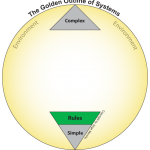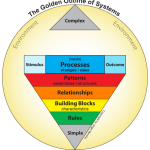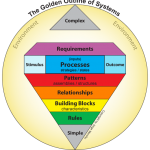
Feb. 09, 2010 (last edit)
What is the Golden Outline of Systems?
The Golden Outline of Systems is a graphical representation of the working fundamentals of a “system”. It is the result of my need to see the generic concept of a system as an assembly and to do so as fundamentally as possible. The goal is to expose the essence of all systems, similar to the relationship of Ohm’s Law to electricity.
As an Assembly
The Golden Outline represents each System element/dynamic as a labeled building block. The building blocks are arranged based on their relationship to each other. The results are the fundamentals of a System depicted as an assembly.
As a Framework
Another important aspect of the Outline is the selection of the key words. Each is carefully selected to be universal and generic. The result is a “system framework” that then becomes easy to build upon. (I also call this a 360° Foundation. More on this topic in future articles.) Note: I selected to use the label “Building Block” over more generic terms such as “element” because it better relates to my need for hands-on!
The Design in General
The System assembly is encased inside a globe that represents the environmental. This is nessary, of course, since every system is part of our environment. The assembly itself is sandwiched in-between the concepts of simple and complex. The complex side representing the system as a whole. The simple side representing the foundation that the system assembly builds from.
The System Core
At the core of all systems are the actions that turn static objects into working systems. Simply, this is called the system processes. Therefore, the core of the Golden Outline of Systems is the “Processes” building block.
The Process building block is sandwiched in-between stimulus and outcome for obvious reasons. All processes have some sort of initial input that initiates the processes of the system, that eventually turn into an outcome.
Above the blue Process building blocks are the dynamics that influence a system.
Below are the components/dynamics that form a system.
More about the System Elements
The following links include more information of the Golden Outline building blocks. Note that they are arranged from the simple side (bottom of the Outline) and progress to the complex (top). It might be helpful to think of it as building a house, starting with the foundation. Just keep in mind, in this case, we are building an Ohm’s Law of systems!
Note that this is a work in progress and is subject to change as I am instpired to do so.
|
• Every system is governed by absolute rules
|
• Every system is composed of building block elements
|
• The building blocks join together through relationships
|
• Joined building blocks form patterns / assemblies
|
|
• The patterns / assemblies are the foundation for the system process
|
|
• Every system has a process that is initiated by a stimulus and results in an outcome
|
• For a system to reach a specific outcome certain requirements must be met
|
| • External conditions can affect the requirements and therefore, the system |
|

|
Powered by Hackadelic Sliding Notes 1.6.5
|
Everything is governed by rules. Everything is built from the rules. Some rules are universal. Others are specific.
Example: The laws of physics are universal. A couple of rules specific to circuits are that every circuit has to have a load and every load has to have resistance.
|
 |
Powered by Hackadelic Sliding Notes 1.6.5
|
Building blocks refers to the quantities / pieces / components that make up systems.
Note that the Golden Outline makes no distinction between a quantity and a component. This allows the “building block” to represent information itself – in any form. Consider the building blocks of computer system machine code: Voltage levels high and low -> 0 and 1 -> binary code. All are building blocks.
Characteristics: All building blocks are defined by their characteristics. This is what makes them unique and determines how a building block can combine and interact with other building blocks. For example, a nut is different than a bolt. Two nuts cannot join together but a nut and a bolt can.
|
 |
Powered by Hackadelic Sliding Notes 1.6.5
|
Relationships are the connection between joined building blocks. It’s the relationships that turn individual building blocks into assemblies; the assemblies that form the system.
The characteristics of the building blocks determine the type of relationships that a building block can make, and therefore its application and function. Consider the building blocks of a simple sentence: A subject, predicate and a modifier. The snow melts quickly.
|
 |
Powered by Hackadelic Sliding Notes 1.6.5
|
All systems are built on some type of pattern / assembly / structure. The patterns provide the apparatus for the system processes.
The term pattern is used for this label because it is more inclusive than terms such as assemblies. For example, a pattern of letters makes words. A pattern of parts is an assembly. An engine (assembly) generates (process) power (outcome).
|
 |
Powered by Hackadelic Sliding Notes 1.6.5
|
The difference between an assembly of parts and a system is a process.
A process is a series of related events or actions that transfers information and/or energy throughout the system. Processes are initiated through an initial stimulus and bring about a result/outcome.
Example: Reading a sentence is a process that combines the meaning of each word into a greater meaning.
Strategy: The way in which a process achieves an outcome is called a strategy.
Example: The selection and arrangement of the words of a sentence defines the strategy that results in the meaning.
State: The building blocks that make up a system often change states to play out the process/strategy.
Example: As a sentence is read the meaning of a word can be qualified or modified by the other words.
Input: Many systems have connections (inputs) from other systems. These inputs can influence the system processes.
|
 |
Powered by Hackadelic Sliding Notes 1.6.5
|
For a system to result in a specific outcome, certain requirements must be met. This applies to the system as a whole and to the individual building blocks as well.
It is important to note, in the context of the Golden Outline, requirements are different than rules, even though all rules are requirements.The difference is that rules refer to the must haves to create a system. The requirements are the must-be-met for the system to produce a specific outcome.
Rule example: All loads must have resistance.
Requirement example: An LED circuit needs a 1k Ohm resistor in series to limit the current though the LED.
|
 |
Powered by Hackadelic Sliding Notes 1.6.5
|
External conditions can influence the processes of a system. For example, the requirements for an expected outcome are dependent on the conditions.
Example: The oil for an engine located in the tropics should be thicker than the oil used on an engine located at the north pole.
|
 |
Powered by Hackadelic Sliding Notes 1.6.5



